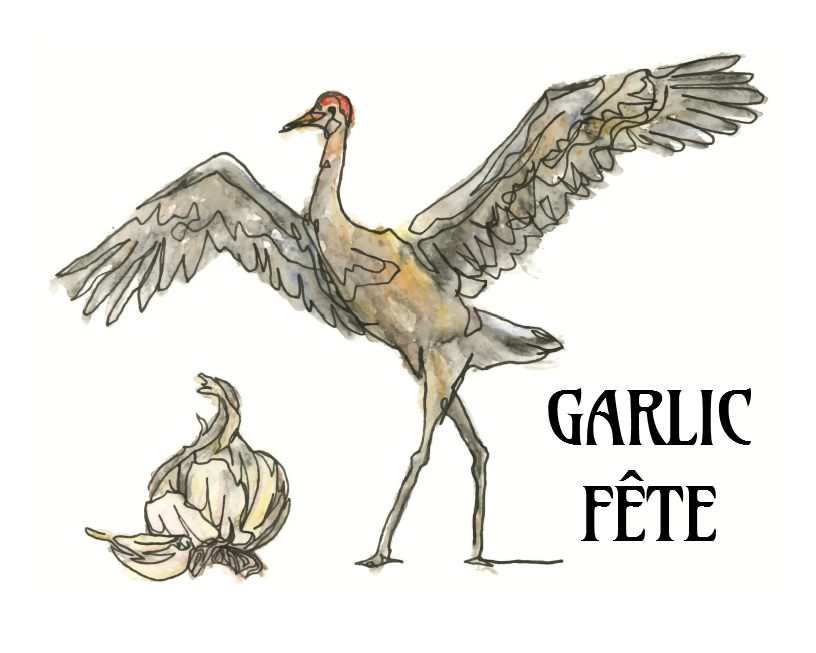What's Happening at the Teton Valley Farmer's Market
By Emily Selleck, Market Elf, Teton Valley News Sep 23, 2020
Mike and Julia Scheller of Garlic Fete, at the People’s Market last year.
Garlic Wranglers. I was intrigued...
As the steady stream of customers began to wane, I approached their booth to ask them for an interview. They were happy to oblige, and provided me with the following.
The newest addition to our Farmer’s Market family, Julia and Michael Scheller, are the proud, hardworking owners of Garlic Fete, growers of Gourmet Garlic Grown in the Teton Valley. Mike, originally from Allentown, Pennsylvania, had spent part of every fifth year in the Northwest since he was seven years old, enjoying the delights of rock climbing, snowboarding, and other athletic adventures to be found in the Tetons. In 2012, he abandoned part-time and moved to live full-time in Alta.
Julia is a Wyoming native who hails from Lander. As a young woman, she moved to southern California. Wyoming, however, frequented her dreams, and in 2011, she moved back to settle in Jackson where she and Mike met at the Wildlife Museum. Attempts at dating ensued. I say “attempts” as their first three dates to get together were snowed out. Mutual affection and persistence won out, and Julia moved to join Mike in Alta in 2015. They were married there at their house on the Solstice, August 21, 2017.
“How did you get into garlic?” I asked them after scribbling down the above information.
Julia was quick to jump in, “We have three acres in back of our house, and we wanted to grow something that would do well here in the high desert. Grapes? Probably not. So we researched garlic, what seemed to us like a manageable crop, and were astonished to learn there are about 600 named species (known as clones as they produce genetically-similar bulbs each time they’re planted). We plant mostly the hard-necked varieties as they ‘co-operate’ well with our harsh winters. Of the 23 different varieties of culinary garlic we plant, only two are soft-neck.”
Mike picks up, “There are three sizes of garlic: seed garlic is the largest; culinary — what we sell — is mid-sized; and, the smallest we use for garlic powders. We recently got into elephant garlic, aglione, of Tuscany origin. It’s actually a very big leek, so it’s still in the allium family.”
“Our 200 square-foot ‘test’ garlic garden began in 2015,” Julia jumps back in. “We were so surprised — it all came up! We get our seed stock from Fort Collins Company, a Certified Organic purveyor in Colorado. Although we do everything organically, we don’t have the official Organic Certification — although we’ve considered it.”
“Tell me more about your organic growing methods,” I asked.
Mike continues, “We build up our soil with our neighbor’s aged horse manure and our own compost. We’re strictly pesticide-free — even for our biggest pests, the pocket gophers and voles — we use physical deterrents. For our other pests — weeds — we hand-pull. And we believe in diversity. Our climate here is so changeable we need to make sure we plant a wide variety of garlic. Each variety has its own unique growing requirements, so some years with certain conditions some varieties do well, and other years with other conditions, other varieties do well. That way, we make sure we have enough garlic bulbs to take to market and some cloves to keep for ourselves!”
“Don’t put all your garlic in one clone!” I chimed in smiling.
“Each variety of garlic (including elephant) takes time to grow, depending upon the number of cloves it has,” Julia continues. “So, if you have a small bulb with few cloves, it takes longer to achieve a marketable amount as you’re able to plant, say, only three cloves rather than six from a larger bulb. All garlic is planted in the fall with a covering of straw over the soil. In spring, the cloves begin to sprout. That’s when we get the scapes we use to make garlic scape powder. The scape powder has a slight ‘garlic-horse-radishy’ taste. The bulbs themselves we harvest in August. They take about three weeks to cure, and then we’re ready for the Markets.
“Last year was our first year selling. We’d originally considered selling on line, but then we decided to try the Wednesday People’s Market in Jackson. We were very well received, and are back there again this year. Folks actually remembered us! This is our first year at the Teton Valley Farmer’s Market, and we’re finding our garlic and powders are flying off the shelves! We believe garlic should be celebrated. That’s why we present it in attractive packaging.”
Julia and I paused to listen to Mike explain to a customer how to keep garlic. “Keep garlic bulbs in a cool dark place. Think ‘wine cellar’! The ideal temperature range is from 50F to 70F — more than 70 you get spoilage, less than 50 you get sprouting. And the relative humidity should be as low as possible. That way, bulbs should keep up to January.
“And as for preparation, treat your gourmet garlic properly with as little cooking as needed. Prior to popping it into the pan, peel the clove then crush it. Let it sit for about ten minutes to allow the allicin in it time to release. Then, chop, mince, or slice the crushed garlic. Add your garlic to the pan at the end of the cooking period for the other ingredients, giving it as little as 30 seconds of actual cooking time. That way you preserve the health benefits as well as the pure taste of your gourmet garlic.”
I can’t wait for dinner!

